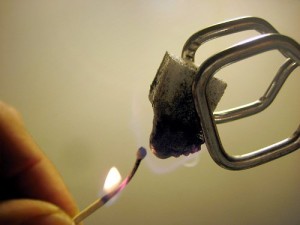

Back in the days of my early teens I belonged to a "science club" that met after school. The science teacher demonstrated many interesting experiments, but the ones that were the most popular were the ones with fire. The most spectacular exothermic demo involved potassium permanganate, sugar, and sulfuric acid that produced a brilliant flame. Another demo was more subtle yet amazing that involved a sugar cube which is the subject of this article.
The teacher explained that sugar is a fuel and suggested that we try to ignite it with a lit match. Try as we might it wouldn't take a flame. He explained that the composition of the sugar required a higher temperature than a match could provide. He then rubbed some ashes (carbon) on the sides, and voila!, it took a flame and burned. He explained that the carbon acted as a catalyst to raise the heat to reach the ignition point of the sugar cube.
We usually refer to this material as "char" which is partially burned or carbonized cellulose. We carbonize cotton swatches by pyrolysis when they are cooked in a can void of oxygen to prevent ignition. We produce nearly black "char" powder when we perform fire-by-friction that when exposed to increased heat produces a coal. Carbon ashes can also be added to fine cellulose to capture weak sparks produced by the flint and pyrite/marcacite fire method.
Another benefit of charred material is that it is dark and thus absorbs heat. This is particularly effective when performing solar firecraft. Carbon is the stepping stone to fire.
I have found that charcoal is also instrumental in the ignition of a campfire. In lieu of using an accelerant, saving bits of charcoal for use in the building of a campfire helps to capture the ignition source and speeds the transition to larger pieces of fuel sized material.
The more you practice firecraft, the more you understand the importance that carbon plays in creating fire.
E-mail your comments to "Ken Youngquist" at info@survivaltek.com
For more information about survival skills and being prepared for emergency situations, visit Ken's website at http://survivaltek.com.
We hope the information on the PrimitiveWays website is both instructional and enjoyable. Understand that no warranty or guarantee is included. We expect adults to act responsibly and children to be supervised by a responsible adult. If you use the information on this site to create your own projects or if you try techniques described on PrimitiveWays, behave in accordance with applicable laws, and think about the sustainability of natural resources. Using tools or techniques described on PrimitiveWays can be dangerous with exposure to heavy, sharp or pointed objects, fire, stone tools and hazards present in outdoor settings. Without proper care and caution, or if done incorrectly, there is a risk of property damage, personal injury or even death. So, be advised: Anyone using any information provided on the PrimitiveWays website assumes responsibility for using proper care and caution to protect property, the life, health and safety of himself or herself and all others. He or she expressly assumes all risk of harm or damage to all persons or property proximately caused by the use of this information.
© PrimitiveWays 2014